The on-chain fee exceeds that of Ethereum SOL. Is it really going to replace ETH?

Reprinted from jinse
12/31/2024·4MWritten by: Joyce
Recently, as Goat, Pnut, Act and other Memes have been listed on Binance, the Solana ecosystem has ushered in a new wave of enthusiasm. According to statistics from Blockworks Research, after October 19, 2024, Solana’s daily on-chain fees have exceeded Ethereum for many days, and its revenue even exceeded 10 million US dollars on October 24. The popularity of the Meme track has attracted funds from all walks of life. Continue to enter the Solana ecosystem, making it the most popular ecosystem in the industry.
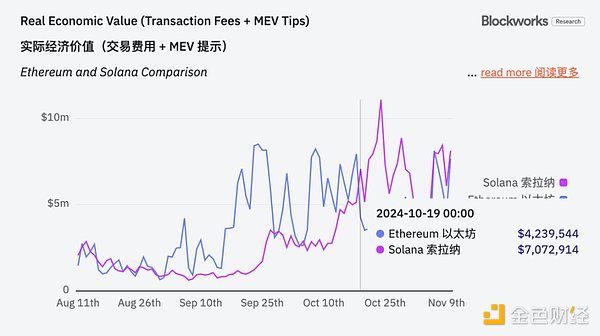
It has to be said that Solana is indeed the most popular chain in this bull market. In the past, more than half of the star projects in the DePin boom came from the Solana ecosystem. After that, there were waves of Meme crazes, which is really lively.
So, where do the high returns we see currently coming from the Solana ecosystem mainly come from? How long can such a hot state last?
Overview of Solana on-chain fees
Similar to Ethereum, Solana’s on-chain income also includes basic transaction fees, MEV tips, etc. After the EIP1599 proposal, Ethereum destroyed all basic Base fees, and MEV tips were directly awarded to verification nodes. Solana also has a similar destruction mechanism, destroying the basic fees at a fixed proportion (initially set at 50%), and the remaining Assigned to validators.
Therefore, when comparing Ethereum and Solana on-chain revenue, all underlying transaction fees that are burned are also included.
Specifically, Solana’s on-chain revenue includes base fees, limited transaction fees, tips (Jito) and voting fees, as shown in the figure below.

Judging from the trend of daily fees on the Solana chain shown in this picture, compared to the other two items, the basic transaction fees and voting fees have not changed much, but the priority transaction fees and tips have gained ground since March this year. Rapid growth.
So, what are these two costs? The priority transaction fee is easy to understand, that is, the fee paid by the user to speed up the transaction. It is usually added directly during the transaction. Tips (Jito) are additional fees paid by users to verifiers, generally used for MEV-related transactions and targeted payments.
The rapid growth of both means that the activity of the Solana network has increased, and the network congestion caused by the increase in DeFi activities has intensified. Users are more willing to increase transaction speed by increasing priority transaction fees, and at the same time, validators capture MEV by optimizing the transaction sequence. Opportunities also increase.
So, what are the specific DeFi transactions on the Solana chain, and are they completely Meme-driven?
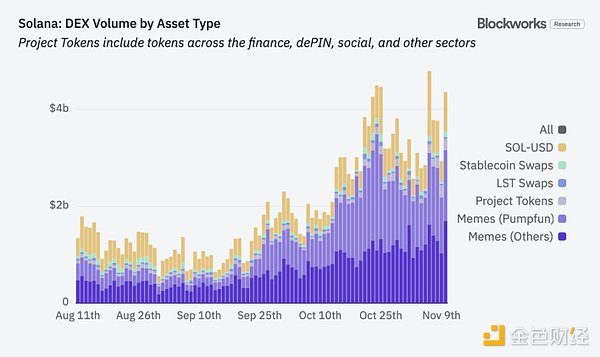
It is not difficult to see from the data in the above figure that the transactions on the Solana chain mainly include Meme (Pumpfun), Meme (others), project Token, LST Token, stable currency and SOL transactions, etc. Among them, in addition to all the categories listed above, the project Token also Including DePin, SocialFi, etc.
In the past two months, the transaction volume of all Meme has increased from 48% to 74%. Of course, the significant reduction in the proportion of other transactions does not mean a decline in transaction volume. When the market is on the rise, the Solana chain Project Token, LST, stablecoin and SOL transaction volumes have all increased significantly. However, the growth rate of Meme is too exaggerated, with an increase of 667% in the past two months. Therefore, the proportion of other transactions has dropped significantly in comparison.
This also confirms the above data, because of the rapid growth of Meme transaction volume, and driven by the belief that "time is money" in Meme transactions, users are naturally more willing to pay priority transaction fees . The more active the transactions on the chain, the more opportunities there are for MEV.
Active Dapps on the Solana chain
1) DEX
Currently, the Solana chain is dominated by Meme transactions. Naturally, DEX is the most active Dapp. Among the DEXs in the Solana ecosystem , the most popular one is Raydium. The data below shows that thanks to the explosion of Meme, currently Raydium, which is deeply tied to Meme, has accounted for 63.5% of the entire Solana ecosystem transaction volume, while Orca, which initially occupied the absolute advantage of the Solana ecosystem, has grown with Meme. With the explosion of transaction volume, market share has been continuously squeezed, from more than 60% to the current level of about 15%.
As a Meme launching platform, PumpFun 's own Meme trading function also accounts for nearly 5% of the transaction volume in this wave of Meme explosion, and it has a gradually increasing trend.
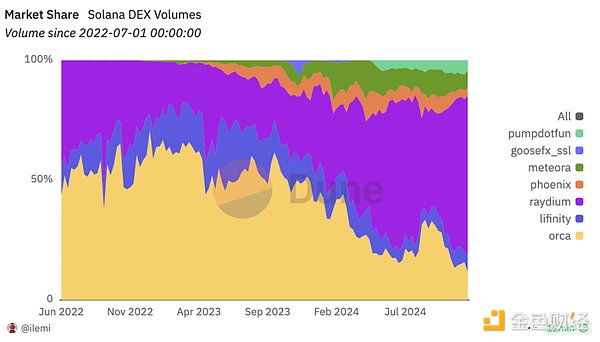
Solana ecological DEX market share, source: Dune.com
2) Aggregation of DEX and trading robots
In addition to direct trading of DEX, aggregated DEX and trading robots in the Solana ecosystem are also very active. The figure below shows the Solana ecological DEX market share by transaction source. The latest data shows that Jupiter’s trading volume accounts for 33%, and other protocols (including trading robots) account for 19%.
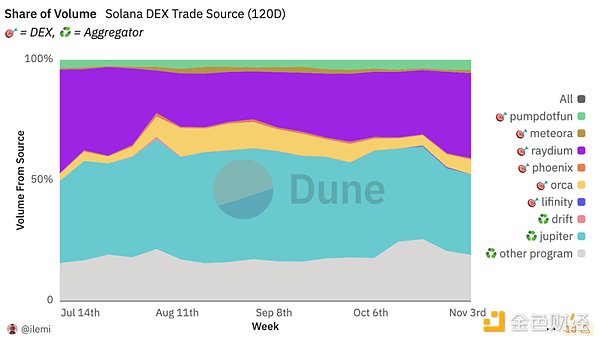
Solana DEX market share by transaction source, source: Dune.com
As the largest aggregation transaction Dex in the Solana ecosystem, Jupiter currently has a TVL of over 1.57 billion US dollars and hit a new high. Jupiter has been making a lot of moves recently:
-
First, on October 2 , the proposal “230 million unclaimed JUPs will be used to extend and fund ASR” was passed, and the Active Staking Reward (ASR) will be extended for another year;
-
Subsequently , the mobile application was launched on October 8, supporting Apple Pay, credit card and other payment methods, and is considered a new French B channel;
-
On October 17 , the Solana MemeCoin terminal "Ape Pro" was launched, focusing on implementing MEV protection and improving the sandwich attack phenomenon in transactions.
-
After a series of actions, the price of Token JUP is also very strong.
In addition to the aggregated trading platform, trading robots in the Solana ecosystem are also very active. More than 10% of transactions are contributed by trading robots. Among them, the top four in terms of revenue are Photon, Trojan, BONKbot and Banana Gun. Photon's revenue in the past thirty days reached US$29.85 million, becoming the protocol with the largest revenue in the Solana ecosystem after the Solana main chain. In addition to the Solana main chain and the Pump protocol, the other three of the top five protocols in Solana's ecological revenue are all trading robots, which shows their ability to attract money.
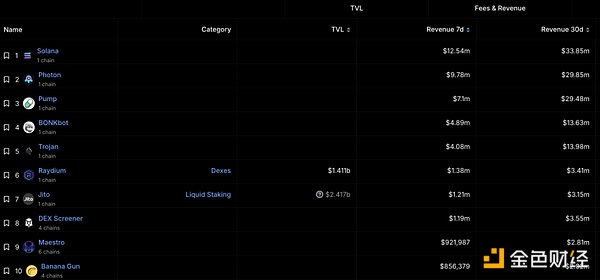
Solana ecological protocol revenue ranking, source: DefiLlama
3) Other Dapps
Although DEX, aggregation DEX and trading robots around Meme are very popular throughout the Meme season, with the popularity of the Solana chain, the price of SOL has also been rising, thus driving staking, re-pledge, borrowing, leverage, etc. in the ecosystem Protocol, the following are some of the more popular Dapps currently.
Jito
Jito is currently the DApp with the highest TVL in the Solana ecosystem, with TVL exceeding US$3 billion, accounting for more than one-third of the TVL of the entire Solana ecosystem. Jito supports users to deposit Solana or Solana's LST Token for re-pledge. Compared with other pledge protocols, Jito 's biggest feature is its MEV suite, which extracts MEV income from transactions in the Solana ecosystem and distributes this income to pledgers. , thereby increasing the income of pledgers.
At present, Jito's re-pledge deposit has reached the hard cap of US$25 million, indicating that the upper limit will be increased in the second phase to meet the staking needs of more users.
Kamino
Kamino is the top stablecoin and LST asset income platform in the Solana ecosystem. It also integrates functions such as borrowing, liquidity provision and leverage. Currently, the TVL of the entire protocol has reached US$2 billion.
Kamino supports one-click automatic compound interest concentrated liquidity strategy, allowing users to maximize returns by controlling borrowed funds. In addition, Lend V2 is expected to be launched in the fourth quarter of this year, which will allow the creation of different borrowing markets without permission to meet a wider range of user needs, as well as the introduction of an automated single-asset borrowing vault to aggregate liquidity across markets, with a view to becoming Solana on-chain finance. base layer.
Marinade
Marinade is also the liquidity staking protocol of the Solana ecosystem, with current TVL of 1.79 billion, ranking fifth after Raydium. However, both are liquidity staking protocols, and the income of the Marinade protocol is far less than that of Jito. Recently, Marinade has been promoting the Solana staking service for institutional investors. In the past month and a half, TVL has increased by nearly 50%.
summary
The Meme craze has indeed driven the enthusiasm of the entire Solana ecosystem. The most direct manifestation is Solana's on-chain revenue and user activity.
However, the current Meme is only the product of a specific period in the bull market. Once it enters the bear market, if the MeMe market no longer continues, how the Solana ecosystem can maintain the leading edge of the public chain is something that needs to be considered. Just like the NFT market that was once popular out of the circle, it is still a mess after the feast. Can Solana take advantage of the popularity of MeMe to create a healthier ecological revenue structure?

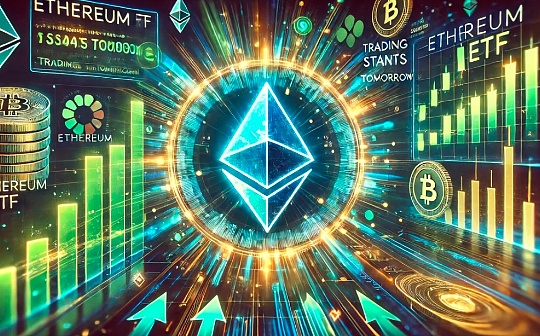
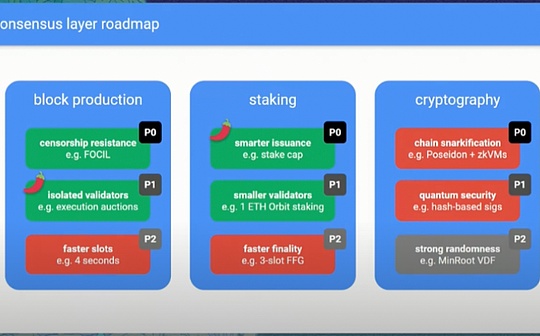


 chaincatcher
chaincatcher